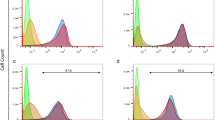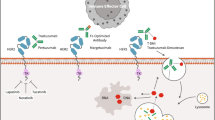Abstract
The HER2 protooncogene encodes a 185-kDa transmembrane protein (p185HER2) with extensive homology to the epidermal growth factor (EGF) receptor. Clinical and experimental evidence supports a role for overexpression of the HER2 protooncogene in the progression of human breast, ovarian, and non-small cell lung carcinoma. These data also support the hypothesis that p185HER2 present on the surface of overexpressing tumor cells may be a good target for receptor-targeted therapeutics. The anti-p185HER2 murine monoclonal antibody (muMAb) 4D5 is one of over 100 monoclonals that was derived following immunization of mice with cells overexpressing p185HER2. The monoclonal antibody is directed at the extracellular (ligand binding) domain of this receptor tyrosine kinase and presumably has its effect as a result of modulating receptor function.In vitro assays have shown that muMAb 4D5 can specifically inhibit the growth of tumor cells only when they overexpress the HER2 protooncogene. MuMAb 4D5 has also been shown to enhance the TNF-α sensitivity of breast tumor cells that overexpress this protooncogene. Relevant to its clinical application, muMAb 4D5 may enhance the sensitivity of p185HER2-overexpressing tumor cells to cisplatin, a chemotherapeutic drug often used in the treatment of ovarian cancer.In vivo assays with a nude mouse model have shown that the monoclonal antibody can localize at the tumor site and can inhibit the growth of human tumor xenografts which overexpress p185HER2. Modulation of p185HER2 activity by muMAb 4D5 can therefore reverse many of the properties associated with tumor progression mediated by this putative growth factor receptor. Together with the demonstrated activity of muMAb 4D5 in nude mouse models, these results support the clinical application of muMAb 4D5 for therapy of human cancers characterized by the overexpression of p185HER2.
Similar content being viewed by others
References
Bishop JM: The molecular genetics of cancer. Science 235:305–311, 1987
Rhim JS: Viruses, oncogenes, and cancer. Cancer Detect Prev 11:139–149, 1988
Nowell PC: Mechanisms of tumor progression. Cancer Res 46:2203–2207, 1986
Nicolson GL: Tumor cell instability, diversification, and progression to the metastatic phenotype: From oncogene to oncofetal expression. Cancer Res 47:1473–1487, 1987
Yarden Y, Ullrich AL: Growth factor receptor tyrosine kinases. Annu Rev Biochem 57:443–478, 1988
Padhy L, Shih C, Cowing D, Finkelstein R, Weinberg RA: Identification of a phosphoprotein specifically induced by the transforming DNA of rat neuroblastomas. Cell 28:865–871, 1982
Schechter AL, Stern DF, Vaidyanatha L, Decker SJ, Drebin JA, Greene MI, Weinberg RA: The neu oncogene: An erb-B related gene encoding a 185,000-Mr tumour antigen. Nature 312:513–516, 1984
Bargmann CI, Hung MC, Weinberg RA: Multiple independent activations of theneu oncogene by a point mutation altering the transmembrane domain of p185. Cell 45:649–657, 1986
Slamon DJ, Clark GM, Wong SG, Levin WJ, Ullrich A, McGuire WL: Human breast cancer: Correlation of relapse and survival with amplification of the HER2/neu oncogene. Science 235:177–182, 1987
Slamon DJ, Godolphin W, Jones LA, Holt JA, Wong SG, Keith DE, Levin WJ, Stuart SG, Udove J, Ullrich A, Press M: Studies of the HeR2/neu proto-oncogene in human breast and ovarian cancer. Science 244:707–712, 1989
Wright C, Angus B, Nicholson S, Sainsbury JRC, Cairns J, Gullick WJ, Kelley P, Harris AL, Horne CHW: Expression of cerbB-2 oncoprotein: A prognostic indicator in human breast cancer. Cancer Res 49:2087–2090, 1989
Paik S, Hazan R, Fisher ER, Sass RE, Fisher B, Redmond C, Schlessinger J, Lippman ME, King CR: Pathologic findings from the national surgical adjuvant breast and bowel project: Prognostic significance of erbB-2 protein overexpression in primary breast cancer. J Clin Oncol 8:103–112, 1990
Berchuck A, Kamel A, Whitaker R, Kerns B, Olt G, Kinney R, Soper JT, Dodge R, Clarke-Pearson DL, Marks P, McKenzie S, Yin S, Bast RC: Overexpression of HER2/neu is associated with poor survival in advanced epithelial ovarian cancer. Cancer Res 50:4087–4091, 1990
Kern JA, Schwartz DA, Nordberg JE, Weiner DB, Greene MI, Torney L, Robinson RA: p185neu expression in human lung adenocarcinomas predicts shortened survival. Cancer Res 50:5184–5191, 1990
Schlom J, Hand PH, Greiner JW, Colcher D, Shrivastav S, Carrasquillo JA, Reynolds JC, Larso SM, Raubitschek, A: Innovations that influence the pharmacology of monoclonal antibody guided tumor targeting. Cancer Res 50:820–827, 1990
Szala S, Froehlich M, Scollon M, Kasai Y, Steplewski Z, Koprowski H, Linnenbach AJ: Molecular cloning of cDNA for the carcinoma-associated antigen GA733-2. Proc Natl Acad Sci 87:3542–3546
Di Fiore PP, Pierce JH, Kraus MH, Segatto O, King CR, Aaronson, SA: erbB-2 is a potent oncogene when overexpressed in NIH/3T3 cells. Science 237:178–182, 1987
Hudziak RM, Schlessinger J, Ullrich A: Increased expression of the putative growth factor receptor p185HER2 causes transformation and tumorigenesis of NIH 3T3 cells. Proc Natl Acad Sci USA 84:7159–7163, 1987
Hudziak RM, Lewis GD, Shalaby MR, Eessalu TE, Aggarwal BB, Ullrich A, Shepard HM: Amplified expression of the HER2/ErbB2 oncogene induces resistance to tumor necrosis factor-α in NIH3T3 cells. Proc Natl Acad Sci USA 85:5102–5106, 1988
Urban JL, Shepard HM, Rothstein JL, Sugarman BJ, Schreiber H: Tumor necrosis factor: A potent effector molecule for tumor cell killing by activated macrophages. Proc Natl Acad Sci USA 83:5233–5237, 1986
Shepard HM, Lewis GD: Resistance of tumor cells to tumor necrosis factor. J Clin Immunol 8:1–9, 1988
Lichtenstein A, Berenson J, Gera JF, Waldburger K, Martiniz-Maza D, Berek JS: Resistance of human ovarian cancer cells to tumor necrosis factor and lymphokine-activated killer cells: Correlation with expression of HER2/neu oncogenes. Cancer Res 50:7364–7370, 1990
Muller WJ, Sin E, Pattengale PK, Wallace R, Leder P: Single-step induction of mammary adenocarcinoma in transgenic mice bearing the activated c-neu oncogene. Cell 54:105–115, 1988
Suda Y, Aizawa S, Furuta Y, Yagi T, Ikawa Y, Saitoh K, Yamada Y, Toyoshima K, Yamamoto T: Induction of a variety of tumors by c-erbB2 and clonal nature of lymphomas even with the mutated gene (Val659 Glu659). EMBO J 9:181–190, 1990
Lupu R, Colomer R, Zugmaier G, Sarup J, Shepard M, Slamo D, Lippman ME: Direct intraction of a ligand for the erbB2 oncogene product with the EGF receptor and p185erbB2. Science 249:1552–1555, 1990
Gill GN, Kawamoto T, Cochet C, Le A, Sato JD, Masui H, MacLeod C, Mendelsohn J: Monoclonal anti-epidermal growth factor receptor antibodies which are inhibitors of epidermal growth binding and antagonists of epidermal growth factor-stimulated tyrosine protein kinase activity. J Biol Chem 259:7755–7760, 1984
Drebin JA, Link VC, Stern DF, Weinberg RA, Greene MI: Down-modulation of an oncogene protein product and reversion of the transformed phenotype by monoclonal antibodies. Cell 41:695–706, 1985
Fendly BM, Winget M, Hudziak RM, Lipari MT, Napier MA, Ullrich A: Characterization of murine monoclonal antibodies reactive to either the human epidermal growth factor receptor or HER2/neu gene product. Cancer Res 50:1550–1558, 1990
Mendelsohn J: Anti-EGF receptor monoclonal antibodies: Biological studies and potential clinical applications. Trans Am Clin Climatol Assoc 100:31–38, 1988
Sarup JC, Johnson RM, King KL, Fendly BM, Lipari MT, Napier MA, Shepard HM: Growth regulation, 1991, in press
Hudziak RM, Lewis GD, Winget M, Fendly BM, Shepard HM, Ullrich A: p185HER2 monoclonal antibody has antiproliferative effectsin vitro and sensitizes human breast tumor cells to tumor necrosis factor. Mol Cell Biol 9:1165–1172, 1989
Aboud-Pirak E, Hurwitz E, Pirak ME, Bellot F, Schlessinger J, Sela M: Efficacy of antibodies to epidermal growth factor receptor against KB carcinomain vitro and in nude mice. J Natl Cancer Inst 80:1605–1611, 1988
Slamon D: Personal communication
Scott GK, Dodson JM, Johnson RM, Sarup JC, Fendly BM, Wong WL, Shepard HM, Benz CC: Manuscript in preparation
Ullrich A, Schlessinger J: Signal transduction by receptors with tyrosine kinase activity. Cell 61:203–212, 1990
Author information
Authors and Affiliations
Rights and permissions
About this article
Cite this article
Shepard, H.M., Lewis, G.D., Sarup, J.C. et al. Monoclonal antibody therapy of human cancer: Taking the HER2 protooncogene to the clinic. J Clin Immunol 11, 117–127 (1991). https://doi.org/10.1007/BF00918679
Accepted:
Issue Date:
DOI: https://doi.org/10.1007/BF00918679




